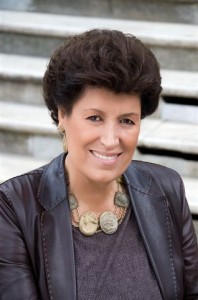
Adele Casagrande
About
the designers
Adele Casagrande was born in 1897. Fendi began in 1918 when Adele Casagrande opened a leather and fur shop in Via del Plebiscito in central Rome.
When Adele married Edoardo Fendi in 1925, they made a decision to change the name to Fendi.
The Fendis had 5 daughters, Paola, Anna, Franca, Carla and Alda. The business prospered, and a new shop was opened in Via Piave in 1932.
By 1946 when Paola was 15, the eldest of the couple's five daughters, went to work for the firm, followed by her sisters Carla, Anna, Franca, and Alda. When their father died in 1954, the 5 daughters took over Fendi and became to expand and develop it.
The first line which the 5 sisters introduced was Furs. They became very famous for their fur coats. In 1965 a marriage between the Fendis and German designer Karl Lagerfeld was sealed, and it proved to be fortuitous for both.
Lagerfeld immediately created the inverted FF logo that joined the growing list of international status symbols.
They shared the work, Paola presided over the pelts, Anna designed bags and accessories, Franca ran the luggage and leather shops, Alda managed the fur salons and Carla (known as the General) was overall supervisor.
The children of these 5 sisters have also grown up in the business and have become Directors of the firm. They have brought out their own label Fendissime.
What had once been a precious but stiff and heavy garment was transformed into a light, soft, easy-to-wear and above all flattering outfit.
The team went on to invent new ways of working with fur, tanning, dying, and treating, and took previously unused skins and turned them into fashionable garments.
By 1966 Fendi had presented its first couture fur collection, designed by Lagerfeld. It was an immediate success with foreign buyers.
Marvin Traub, president of Bloomingdale's, discovered Fendi's leather goods and introduced them to the United States. Other outlets soon followed, and today Fendi has a large store on New York's Fifth Avenue, as well as numerous Fendi boutiques around the world like London, Paris, etc.
In 1969 Fendi presented its first ready-to-wear fur collection at Palazzo Pitti in Florence, bringing continuously evolving techniques and imaginative designs to lower-priced furs without sacrificing quality.
When the sisters couldn't find the fabric clothes they wanted to show under the furs their ready-to-wear line was born, again to great success.
In 1978 Adele Casagrande Fendi died when she was 81 years old.
In 1990 Gianbattista Valli worked for a year as designer for the new line of Fendissime.
In 1999, Fendi sold 51% of their stock to a Prada/LVMH joint venture. It was rumoured that the family members were feuding over this decision. Finally in 2001, Patrizio Bertelli sold Prada's 25 % stake to LVMH for 182 million pounds, due to mounting debt. So currently LVMH owns the majority of the shares in Fendi.
Paola Fendi's daughter Simona (born 1965) had become an expert on fur fashion designs. She died in November 2003 of a lung embolism. The company will miss her.
Every year for more than a century, the American Academy in Rome awards scholarship to 15 emerging artists. For the first time this year, the fashion scholarship is being established under the auspices of the Fendi Rome Prize. Like other fellowships under the Fendi Rome Prize, the winner will be able to live and work at Fendi in Rome. The winner will be declared in April 2006.
In November 2005, Fendi celebrates it's 80th anniversary, as well as the opening of it's new flagship boutique in New York city. The house has a lot to celebrate this month.
Fendi's newest brand offering a wide variety of home furnishings. Furniture, sofas, armchairs, poufs, chaise-longues, consoles, day-beds: items of everyday life seen, interpreted, and lived with the typical Fendi style and culture. Above all this there is one common denominator: the home seen once more as the heart of a lifestyle, small pieces of furniture acting as a support for the most immediate and practical needs and more significant pieces to be personalised according to the taste. Great attention is paid to the past while tending towards the future, with considerable concern for evolution in modern design, which is interpreted, enjoyed and shared in the spirit of today’s culture. And so we find objects for the home distinguished first of all – as is the entire creation of Fendi - for their fine quality: great care and attention in the choice of fabrics and their combinations, and in the 'mix' of materials which creates new forms. All this together with the craftsmanship and attention to detail, the careful working and hand finishing, the personality which is an integral part of Fendi style. And last but not least, that creativity and imaginativeness which come from research and experiment, a mood which extends from fashion to design through the creation of personalised and personalising objects.